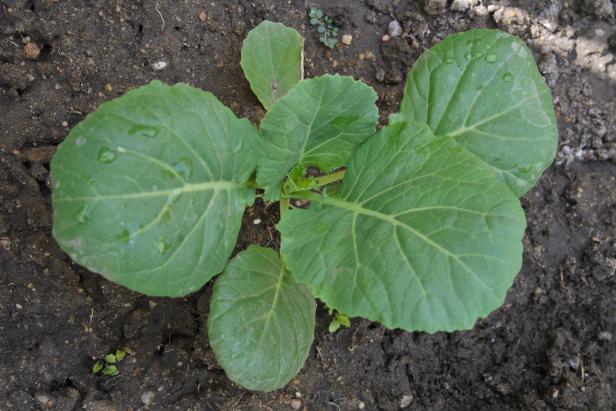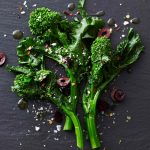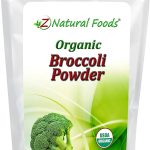Yes, broccoli leaves are edible and nutritious. Broccoli leaves are not only healthy but also tasty, making them an excellent addition to your diet.
These leaves come from the same plant as broccoli, and they are rich in vitamins A, C, and K, calcium, iron, and fiber. They have a slightly bitter taste similar to kale or collard greens, making them perfect for stir-fries, soups, and salads.
Eating broccoli leaves can also help reduce food waste, as many people tend to discard them. However, it is important to note that when consuming broccoli leaves, you should ensure that they are thoroughly washed, and the toughest parts of the stalks are removed. We’ll explore the nutritional properties of broccoli leaves, how to prepare them, and some delicious ideas on how to incorporate them into your meals.

Credit: www.dare2dreamfarms.com
The Broccoli Leaf Debate
Broccoli leaves are often overlooked, but they are a highly nutritious and edible part of the plant. In fact, broccoli leaves have more vitamin A, vitamin K, and calcium than the florets, making them a great addition to your diet.
The taste and texture of broccoli leaves are similar to that of kale or collard greens; they have a slightly bitter taste and a chewy texture. To prepare broccoli leaves, remove the tough stem and chop the leaves into bite-sized pieces.
| Nutritional Content of Broccoli Leaves | |
|---|---|
| Vitamin A | 212% |
| Vitamin C | 115% |
| Vitamin K | 460% |
| Calcium | 16% |
Overall, broccoli leaves are a healthy and delicious addition to your meals. So, don’t discard them just yet!
Broccoli Leaves In Different Cuisines
Besides the florets and stems of broccoli, its leaves are also edible and packed with nutrients such as vitamins A and C, calcium, and fiber. Many cuisines around the world use broccoli leaves in their dishes to add flavor and texture. For instance, Italian cuisine incorporates broccoli leaves in soups and pastas. In Chinese cuisine, stir fry and dumpling recipes include broccoli leaves. Furthermore, Indian cuisine blends the leaves in dal, a popular lentil soup.
| Broccoli Leaves in Italian Cuisine | Broccoli Leaves in Chinese Cuisine | Broccoli Leaves in Indian Cuisine |
|---|---|---|
| Soups and pastas | Stir fry and dumplings | Dal (lentil soup) |
Preparing Broccoli Leaves For Cooking
Broccoli leaves are not only edible, but they are also a nutritious addition to any diet. Before cooking broccoli leaves, there are a few steps that need to be followed to ensure they taste their best.
Washing Broccoli Leaves
The first step is to wash the broccoli leaves thoroughly. Use cold water to rinse the leaves, and gently rub them with your hands to remove any dirt or debris.
Removing Tough Stems
Next, remove the tough stems towards the bottom of the leaves that are not edible. Use a sharp knife to cut these off.
Cutting Broccoli Leaves Into Bite-sized Pieces
Once the stems are removed, it’s time to cut the broccoli leaves into bite-sized pieces. Cut the leaves into 2-inch pieces to make them easier to cook and eat.

Credit: www.foodnetwork.com
Cooking Broccoli Leaves
Broccoli leaves are not only edible but also packed with nutrients. Sauteing is a quick and simple way to cook the leaves. Heat olive oil in a pan and add chopped garlic. Stir for a few seconds before adding the leaves. Cook for 4-5 minutes, stirring occasionally.
Blanching the leaves is another easy option. Boil water in a pot and add the leaves. Cook for 2-3 minutes until they turn bright green. Drain the water and transfer the leaves to cold water to stop the cooking process. Squeeze out the excess water before using.
Stir-frying is a great way to add more flavor to the leaves. Heat oil in a wok or skillet and add ginger and garlic. Add the leaves and stir-fry for a few minutes until wilted. Add soy sauce or other seasonings to taste.
Roasting broccoli leaves can give them a crispy texture. Preheat the oven to 400°F and line a baking sheet with parchment paper. Spread out the leaves and drizzle with olive oil. Season with salt and pepper before roasting for 8-10 minutes. Enjoy!
Recipes Featuring Broccoli Leaves
Broccoli leaves are not only edible, but also a nutritional powerhouse. Here are some delicious ways to use them in your cooking.
| Recipe | Description |
|---|---|
| Broccoli Leaf and Cheese Frittata | A protein-packed breakfast or brunch dish that’s easy to make and full of flavor. Sauté broccoli leaves until wilted, whisk together eggs and cheese, then pour into the skillet and bake until golden. |
| Broccoli Leaf Pesto | A tasty and unique twist on the classic pesto sauce. Combine broccoli leaves with garlic, pine nuts, Parmesan cheese, and olive oil in a blender. Serve drizzled over pasta, on bread, or as a dip for vegetables. |
| Stuffed Broccoli Leaves | A fun finger food that’s perfect for parties. Blanch the leaves to soften, then fill with a mixture of ricotta cheese, lemon zest, and chopped herbs. Roll up and serve with a dipping sauce. |
| Broccoli Leaf Salad with Lemon Dressing | An easy and refreshing side dish that’s loaded with nutrients. Mix chopped broccoli leaves, sliced radishes, and crumbled feta cheese in a bowl. Whisk together lemon juice, honey, and olive oil for a simple dressing. |
Benefits Of Eating Broccoli Leaves
Broccoli leaves are not only edible, but they are also highly nutritious. They are rich in antioxidants, fiber, and vitamin C, which can help boost immunity, promote healthy digestion, and reduce the risk of chronic illnesses. Adding broccoli leaves to your diet can have several health benefits.
Broccoli leaves are edible and actually contain more vitamins and minerals than the florets. They are a rich source of vitamin A, vitamin C, calcium, potassium, and iron. Additionally, they contain anti-inflammatory properties which may help reduce inflammation in the body. Eating broccoli leaves can also promote good digestive health due to their fiber content. Regular consumption may help prevent certain diseases such as cancer due to their high level of antioxidants. Adding broccoli leaves to your diet is an easy and healthy way to boost your nutrient intake.
Considerations When Eating Broccoli Leaves
Eating broccoli leaves can be a nutritious addition to your diet. However, there are some considerations you should keep in mind for your health and safety.
Pesticides and Chemicals:
Broccoli leaves may contain pesticides or chemicals that were used during the cultivation process. Choose organic broccoli leaves to avoid exposure to harmful substances. If you cannot find organic leaves, wash them thoroughly with cool running water to remove any residual pesticides or chemicals.
Moderation is Key:
While broccoli leaves are a great source of vitamins, minerals, and antioxidants, they should not be considered a main source of nutrition. Incorporate them into your diet in moderation, and do not consume them to excess.
Allergies and Sensitivities:
If you have a known allergy or sensitivity to broccoli or other cruciferous vegetables, you may want to avoid eating broccoli leaves. These leaves contain similar compounds that can trigger an allergic reaction in some individuals.

Credit: gardenmentors.com
Frequently Asked Questions For Are Broccoli Leaves Edible?
Are Broccoli Leaves Good To Eat?
Broccoli leaves are edible and contain more nutrients than the actual head. They are rich in vitamins and minerals and can be prepared like any other leafy green vegetable. Just make sure to wash them thoroughly before cooking.
What Parts Of Broccoli Are Not Edible?
Only the tough, fibrous parts of the broccoli stems and leaves are not edible. The florets and tender part of the stem are edible and nutritious.
How Do You Harvest And Eat Broccoli Leaves?
To harvest and eat broccoli leaves, wait until the leaves are mature, pick the leaves from the bottom up, and rinse them thoroughly. You can eat broccoli leaves raw or cooked, depending on your preference. Simply chop them up and add them to a salad or sauté them with garlic and olive oil.
Are Broccoli Leaf Stalks Edible?
Yes, broccoli leaf stalks are edible. They have a mild, slightly bitter taste, but can be prepared in various ways, such as sautéed, roasted or added to soups and stews. They are also rich in vitamins and minerals, making them a nutritious addition to any meal.
Conclusion
Broccoli leaves are indeed edible and pack a nutritional punch that rivals its florets. As an excellent source of vitamin A, C, and K, they are a tasty addition to any dish and should not be discarded. However, it’s crucial to be mindful of pesticides, and it’s best to purchase organic broccoli leaves when possible.
So don’t let those greens go to waste and start incorporating them into your meals for a healthy boost.

I am a graduate of Bangladesh Agricultural University, where I delved into various agricultural disciplines, equipping me with a profound understanding of agriculture. Beyond academics, I have hands-on experience in gardening and crop cultivation. My passion is to embrace sustainable farming and horticulture. With a BSc in Agriculture, I am dedicated to promoting environmentally conscious and efficient agrarian practices.
Bachelor of Science (BSc) in Agriculture (Hons.)
Master of Science. (Sustainable Agriculture & Food Security ) (MS)
Bangladesh Agricultural University



